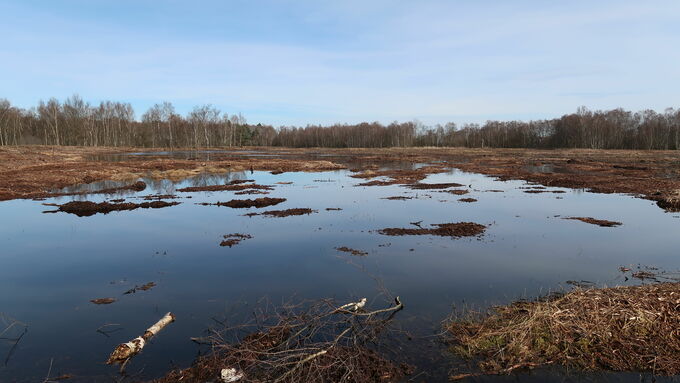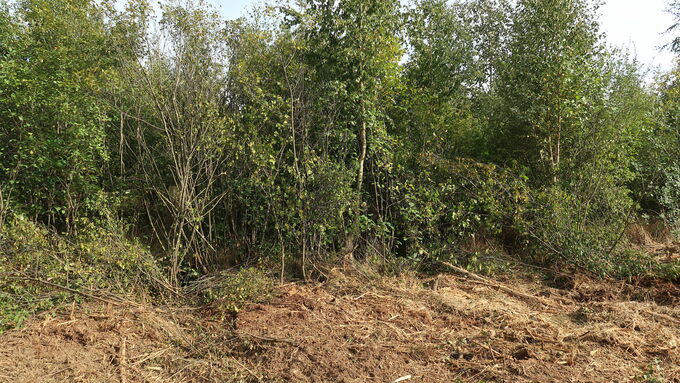Flooded peatland area in March 2023 (view from south to north). © Dirk Esplör
download picturemain content
Project of the month
#04/2023 #04/2023 WEIẞES MOOR (DISTRICT OF MINDEN-LÜBBECKE)
Peatland restoration and management of small waterbodies and wet heaths
The SAC ‘Weißes Moor’ in Rahden-Tonnenheide is one of the few remaining typical peatland areas in the physical region ‘Rahden-Diepenau Geest’. The area which is located in an agriculturally cultivated environment is of particular importance as a very important stepping stone biotope for other peatlands in the physical region (Großes Torfmoor, Oppenweher Moor, Uchter Moor). However, the hydrologic balance of the raised bog area already showed strong fluctuations, so that a clear ‘falling dry’ could be observed. In contrast, the ponds and small waterbodies on the edge of the nature reserve still showed ‘normal’ conditions. The temporary drying-out of the core zone caused increasing scrub encroachment on the raised bog. In order to be able to assess the restoration potential of the peatland, a hydrological survey report was first commissioned (see Action A3), which was completed in March 2020. According to this report, the peatland has a high development potential, provided that rewetting is successful and would lead to comparatively near-natural water levels in large areas. The expansion of endangered vegetation typical of raised bogs with a high degree of sphagnum moss cover seemed possible over a large area if the site conditions were optimized. The conservation status of the SAC habitat types associated with peatlands (e.g. habitat types 7120, 7140 and 91D0) could thus be significantly improved.
From September 2022 to February 2023, various measures for peatland restoration, heath and waterbody management were therefore carried out within the framework of the LIFE IP in cooperation with the Lower Nature Conservation Authority of the District of Minden-Lübbecke and the Biological Station Minden-Lübbecke. In the first step, the scrub on the peatland areas shown in the action plan were mechanically cleared. In the process, the extensive woody growth, especially of birch and alder, but also grey willow scrub, was removed with the help of a tracked caterpillar with forestry mulching equipment. At the edges of peat cuttings and particularly small peat cuttings, a peatland-suited tracked excavator with forestry mulching equipment was used. Stronger individual trees and groups of trees were felled, processed and removed in a separate work step. A tracked excavator with tree shears was used for this purpose. The removal was carried out with minimal damage to the soil, using a tractor with twin tyres and a special timber trailer with rubber track units. This made it possible to reduce the amount of wood chippings on the area significantly in order to improve the regeneration possibilities of the typical peatland plant species. In order to create development opportunities for a downy birch forest in the north of the area, non-native Sitka spruces were removed and moved with a logging horse to two forest tracks with minimal damage to the soil.
To improve the hydrologic balance of the peatland, 8-10 metres long ditch closures were built at five locations from peat extracted on site. The ditch closures were each covered with coconut fibre mats as protection from erosion.
The bush-encroached small waterbodies and wet heaths in the surroundings of the peatland were first cleared of scrub using a forestry mulcher on a tracked excavator suitable for bogs. Vegetation sites with particularly rare plants (arnica, royal fern, and sweet gale) were marked in advance and left out during work. In some areas, the top soil horizon was additionally removed in a layer thickness of 5-15 centimetres in order to initiate regeneration of the overaged wet heaths. The removed material was embedded as a thin layer in the area of a pathway and on a pathway embankment and levelled. Some of the material was also used to fill in sections of a ditch profile in the south of the area.
The work carried out is to be understood as an initial restoration. Further optimizations are planned for the fourth project phase: woody plants are to be removed from further areas, peat ridges are to be levelled and further ditches are to be closed.
However, further management to stabilize and restore various habitat types (e.g. 7140 and 4010) will be necessary in the next few years to prevent the reshooting of woody plants.





